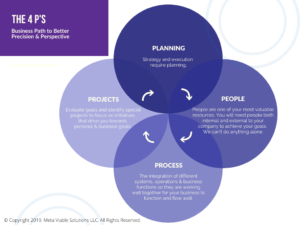Tag: Fractional Leadership
Jumpstart Your Business Growth With a Fractional COO


“I dream things that never were, and I say ‘Why not?'” — George Bernard Shaw
As an entrepreneur, you leapt headlong into your venture without all the answers, confident you’d figure out what you need to know along the way. Wearing many hats and spinning lots of plates, you inspired others to join you, and, together, you grew. Now your business has hit an impasse or plateau. You know what got you here isn’t going to get you where you want to go. But you’ve maxed out your capacity and don’t have the in-house knowledge, skills, experience, or perspective to do what’s necessary to take things to the next level.
If this sounds like you, congratulations! You’ve already built a viable small business. What’s more, you may be just one key hire away from jumpstarting your next phase of breakthrough growth.
Why a Fractional Leader?
With the fractional model, you gain access to a higher level of executive leadership whose talent and experience would otherwise be unavailable to you. Fractional leaders aren’t cheap, but they can be affordable to a small business or cash-strapped startup because they work only part-time for each client and typically don’t require benefits or equity.
In essence, you’re “renting” a fractional executive for a period of time to help your business grow to the next level. Once your fractional executive has accomplished that goal for you, they’re usually happy to help you find, hire, and groom their full-time replacement, if necessary. Then they move on to their next growth challenge — generally what excites them most.
You may be wondering: With so much to do, how can a fractional executive possibly transform my business if they’re not working full time? The short answer is it depends on how you use them. If you’re looking for someone to take mundane tasks off your plate, you’re unlikely to achieve the level of growth you’re seeking.
But if you let them focus primarily on growing the business, an experienced fractional exec can get the job done much faster, more effectively, and with far less risk than a first-timer. One way to think of it: hiring a fractional executive is like plugging your business into a higher voltage battery. While you may not need to use all the battery’s power to run your company just yet, the engine that will drive your business’s growth won’t even start without it.
Why Start With a Fractional COO?
Today, you can hire all kinds of fractional executives — CMOs, CFOs, CHROs, etc. Many founders/CEOs build whole teams of fractional executives to grow their businesses. However, if you’re considering your first fractional hire, and you need help growing your business more or less across the board, you may be best off starting with a fractional chief operating officer (COO).
Why? While the function of a COO varies from business to business, the scope of a true COO’s responsibility is the entire organization, not just a single business function. They must take a holistic view of the business and understand how it all works together as a dynamic system — made up of interconnected functions, processes, inputs and outputs — itself part of an even larger system, for example, the marketplace.
In addition, a fractional COO often has deep hands-on experience in most, if not all, aspects of a business — sales, marketing, product development, finance, technology, HR, customer service. They not only understand the system as a whole but also have at least working knowledge of the different subsystems and how they all relate to each other and the whole.
To use a medical analogy, one of the functions of a good COO is to serve as a sort of trusted primary care physician who can evaluate the health of your entire business, make accurate diagnoses, prescribe the right treatments or cures, and refer you to specialists as necessary.
To carry the analogy further, they must also have an excellent bedside manner, knowing how to communicate effectively with all different types of employees, across all functions and contexts, 360 degrees, as well as customers, vendors, partners, investors, and so on.
Executing for Business Growth
However, the “doctor” analogy stops there. A fractional COO isn’t a mere consultant who spends the metaphorical equivalent of 15 minutes examining your business, writes you a prescription, and then beats a hasty retreat. No, a fractional COO works in your business as well as on your business, moving fluidly from analysis, strategy, and planning to execution; driving progress each week; holding people accountable for results; testing, measuring, learning, and — if they’re doing their job — continuously improving performance and growing your top and bottom lines.
As Oliver Wendell Holmes said, “Many ideas grow better when transplanted into another mind than the one where they sprang up.”
A great fractional COO will take your vision and run with it, in the process making your long-sought business dream a present-day reality. You can learn more about the benefits of fractional leadership here.
About the Author
Mark Scrimenti is a Fractional COO and Fractional Integrator for businesses running on EOS. He has 15-plus years of leadership experience in e-commerce, digital product development, sales, marketing, and customer experience. Connect with Mark on LinkedIn or visit his website at vividpathconsulting.com if you’re ready to jumpstart your own business’s growth.
5 Steps for Setting Up Your Fractional Services Business


Congratulations! You’re launching a fractional services business. Providing fractional services benefits both you — allowing you to live your ideal life — and those entrepreneurs seeking your knowledge and expertise to take their business to the next level.
Step 1 – Ideate Your Fractional Business Plan
Step one in setting up your fractional practice is defining who you are, what unique services you offer, and whom you will provide services. In addition, deciding how you provide value and for what cost is key. Whether you use an operating system such as Entrepreneurial Operating System (EOS®) where the V/TO is foundational, or you develop a business plan outlining your strategy and goals, the creation of your business plan comes first. Include any personal or professional partners in the discussions for support.
STOP HERE — IMPORTANT!!! As you launch, be certain you have undertaken the necessary steps to understand the financial impact building a new practice can bring. Having stable savings from which to draw the first year is essential. The time and efforts of relying on clients to pay invoices on time and develop, send, and follow up on those invoices should not be underestimated. Ok, now you can keep reading…
Step 2 – Develop Measurable Goals
Layered on the business structure should be specific and measurable goals, both professional and personal. What does the life you want to live look like? How will you make that ideal life a reality? Where do you bring value to your clients? What are your passions, and how do you translate those passions to make a difference? With what types of people do you work best? Who then is your ideal client? These are all questions to consider — among others.
Step 3 – Setup Your Business Name
Once your fractional services business is defined, select a name. Carefully choose a unique moniker that allows others to identify the nature of your business easily. Then register the name and chosen structure (LLC, S-Corp, etc.) in your local jurisdiction, partnering with appropriate legal and financial entities to ensure proper adherence to rules and regulations.
Step 4 – Determine Your Fractional Services
Identify your service offerings based on your ideal client needs, layered with the value you can provide. When it comes to pricing, remember that we always tend to under-value our worth. It is always a good idea to run your pricing structure by a mentor or valued partner (preferably someone in a similar type of business).
Step 5 – Get Out There and Network
You’ve likely been networking throughout creating and building the business. Perhaps you even have your first client — or three — set to sign with you as soon as you’re ready! Open, honest, and authentic conversations with your network and potential clients will return to you in spades. Be clear about who you are, what you offer, and the value you provide. At the same time, know when to say “no.” By staying true to your personal and professional core values, the benefit you bring is that much stronger.
With a good business plan in place, your ideal personal life outlined, your value proposition, pricing, and business name defined, you’re ready to work with clients. Be realistic about the time required both ON the business and IN the business.
Your calendar is your best friend. Schedule days/time for business development, work with clients, and administrative duties. Then seek out organizations where your ideal clients are tuned in. Participate, give back, and use those resources to stay in front of those perfect clients. You can also join the Fractional Leadership Network.
Peer groups and valued partners can be important referral sources for the delegation of business areas that do not play to your strengths or when additional help is needed. Delegation in your personal and professional life is the key to getting the things you should not be doing off your plate and giving you the time to focus on your Unique Abilities. One example: I have not cleaned my house in seven-plus years. I hate cleaning; it’s a distraction for me. Seeing dog hair in the corner doesn’t bother me, knowing Cindy will be here in a few days to clean. I am also supporting Cindy and her small business — a total win/win!! Remember: just because you CAN, doesn’t mean you SHOULD.
Now, Reap the Rewards
Fractional work is a balancing act. The rewards can be huge! Patience, persistence and understanding you are running a marathon — not a sprint — are all necessary. Congratulations on building your fractional practice! Now get out there and offer your expertise to the world with confidence!
About the Author
Jamie Munoz is the founder and visionary of a team of Fractional Integrators at Catalyst Integrators, helping busy visionaries and entrepreneurs maximize their potential by running companies on EOS. Jamie is also a certified John Maxwell Team coach, speaker and trainer. Contact Jamie here.
Mergers and Acquisitions — Selling Your Small Business


Your fiercest competitor has just submitted a letter of intent to acquire your business. How do you respond? Is the offer a good one? Is it the right time to sell? What are customary terms and deal processes? If you’re like approximately 90 percent of business owners out there, you’ve never been involved with the sale of a business (particularly your own). You would likely have a host of questions similar to these.
Business sale or sell-side mergers and acquisitions (M&A) transactions are “unique beasts,” and the stakes are too high to go it alone or enter the fray without the proper advisors.
If you’re prudent and well prepared for a sale, you can avoid the mistakes that befall many an unsuspecting seller. These can include an outsized strain on your day-to-day operations, suboptimal deal terms and value (i.e., lower sales price and unattractive terms), and an inefficient deal process. Remember that it is critical to communicate — whether orally, in writing, or through the sharing of company information — with intention and that “time kills deals.”
Hiring a Fractional Leader Can Optimize Your Business for Sale
Working with experienced fractional leadership (CMO, CSO, COO, etc.) months or years ahead of a prospective transaction — whether vaguely conceptual or immediately actionable — can supplement your core team. Domain experts can supercharge your operations and optimize the value and attractiveness of your business.
Additionally, a Fractional CFO experienced in M&A can provide transaction-related guidance alongside ongoing strategic financial oversight. When the time comes to “go to market” (proactively pursue a sales process) or respond to the unsolicited acquisition offer, you’ll have experienced advisors on hand. And you will be prepared with financial results and operating data tailored to your audience of third-party investors and acquirers.
Regardless of whether a transaction is ultimately pursued or consummated, by going through the process, you’ll likely have received outsized value in the form of a more sustainably profitable and well-run business.
About the Author
Landon Mizuguchi has over 15 years of experience encompassing M&A, general management, corporate finance, and valuation, with preeminent professional services firms such as Goldman, Sachs & Co. and EY (formerly Ernst & Young). As principal of Malama Capital Advisory, he provides Fractional CFO and M&A advisory services to West Coast-based SMBs and hyper-growth startups. Contact Landon here.
Your Business and the Power of Process


As founder and fractional chief operations officer (COO) of Meta Viable Solutions, I have realized the Power of Process and how it can benefit businesses regardless of size. Process is integral in building a strong business from the ground up. It allows you to provide efficient business models that will help your business produce, grow, scale and profit.
Process also allows you to pivot and tweak your business, when necessary, as all systems don’t work all the time. As a leader and visionary in your company, process allows you to execute your great ideas into tactical, approachable steps to reach high-level goals.
A Business Path to Better Precision and Perspective
The 4P Model for a Business Path to better Precision and Perspective allows business objectives to be realistic and manageable. This model helps with effectiveness and efficiency when managing your team and avoiding employee burnout. It infuses your company with productivity, motivation, ingenuity and progress.

The 4P Model consists of Planning, People, Process and Projects. These four elements are all interrelated and must work together for you to be successful. You can’t have new systems and technologies without people.
There needs to be planning, process integration, training and special initiatives or projects to get ideas and plans off the ground. One can’t exist without the other.
- Planning is key before embarking on a new initiative. We often refer to this stage as strategic planning. It allows you to put the required people, budgeted finances, and time in place
- People are one of your most valuable resources. You will need people both internal and external to your company to achieve your goals. What roles and expertise do you need to accomplish your business goal or project?
- Process is needed to integrate different business functions, experts, systems and operations in your company, so they are working well together. How will you get to where you are going? You will need to ensure everyone is working together and the right communication processes and workflows are implemented.
- Projects are a means to the end goal if they are planned, managed and executed well. Your company may have several business initiatives occurring simultaneously. How do you prioritize, track and manage them? Projects allow a way to assign responsibility to team members, evaluate goals and identify special projects to focus on initiatives that drive you toward professional growth and business goals.
Delegating people internally or hiring a team, consultant or Project Management Professional (PMP) can help create manageable and practical projects to reach your business goals.
Successful Businesses Realize What Process Can Do for Them
Let’s take a minute to focus on number three, PROCESS.
The EOS Traction method recommends that all you need is 80 percent of your six core processes documented at 20 percent. It suggests that every company has at least six core processes: Human Resources, Marketing, Sales, Operations, Accounting and Customer Retention.
Well-documented and communicated processes are invaluable and beneficial to your company. Whether you are a one-person business or a 250-employee company, you have processes within your company. You have a method and technique you have developed to work internally and externally with others. These “processes” may be documented, or they may be in your head.
The question is, are they effective, and is everyone working off your built-in processes?
Effective processes save you time, money, and resources in the short and long term.
Four Benefits of Establishing Processes
- Clear processes create a clear direction for your employees, customers and strategic partners. It develops transparency and sets expectations of how policies, procedures and tasks are to be performed. Everyone involved understands how matters will be handled before proceeding with a task. Process mapping, documentation and training are best practice tools to communicate your processes to all those involved internally and externally.
- Process ensures better quality assurance. Having clear processes allows for more consistency and less variance in errors. It allows for productivity and efficiency. Process helps your employees understand their role in the larger context of the company and better meet company standards. Additionally, customers can expect a certain positive level of customer experience when it comes to customer care. Process allows similar quality standards, so your team is accountable, responsive, and meeting a certain standard with your product, service and professionalism.
- Process allows you to build systems and capacity. It is a foundational element (a part of the 4 P model) to integrate different functions and people within the company. It allows for consistency across multi-sites and helps you expand your business once you develop a successful, efficient process model (one that works for you and your customers).
- Process saves you time and money. Everyone is on the same page and understands how things are done, avoiding the loss in time and “figuring things out.” You will experience higher employee and customer satisfaction and better external strategic partnerships with established processes. Process allows you to be resourceful and less prone to liabilities.
Oftentimes, business owners and leadership feel lost and overwhelmed when starting or pivoting a business. Consider Fractional Leadership. Hiring a Fractional Leader can help bring your team and business forward.
If you found these concepts helpful and would like a deeper dive into strategic, practical tips and an easy-to-follow guide on building a stronger foundation for your business, pick up a copy of my book, Striking Business Gold: Build, Scale, Profit for Success.
About the Author
Sasha Lalite, MPA, PMP, is the owner and Fractional Chief Operations Officer of Meta Viable Solutions LLC. As a Fractional COO & Strategic Operations Advisor, Sasha provides expertise to businesses on an outsourced, part-time, or project basis. Connect with Sasha here. She can also be reached at sasha@metaviablesolutions.com or 347-470-7901.
5 Tips to Get Your Revenue Flywheel Spinning for 2022


The Sales Funnel concept is increasingly being replaced by a new concept in customer acquisition — the Revenue Flywheel. I know this because the term keeps coming up in casual conversation with a few private equity folks I work with.
At first, I didn’t recognize the term. Then I remembered Jim Collins’ management book, Good to Great: Why Some Companies Make the Leap…and Others Don’t and his description of the flywheel effect.
He has the reader imagine a large and heavy metal flywheel (a wheel used to store and smooth out energy delivery, as in an engine) and the effort required to get it moving. The first push moves it very slightly, the second a bit more, the third even more (thanks to the momentum of the earlier two pushes added to its own) and so forth.
Finally, all those little pushes get the big flywheel rolling along with ease. Still, there wasn’t a single push that did it — you have to consider all the little efforts which contributed.
Applying this to a business, Collins explains that it’s the accumulated day-to-day effort of an organization that leads to its flywheel spinning faster and faster, rather than a single defining action.
Too often, however, teams change direction in attempts to bypass the “arduous buildup stage.” They lose momentum by chasing grand slams instead of simply getting on base. They progress in fits and starts, or not at all because efforts aren’t aligned. Some are pushing the flywheel forward while others are applying the brakes.
The Revenue Flywheel
Our approach at Volohaus has always been more flywheel than funnel. There are four main areas we focus on: PLAN, PEOPLE, PROCESS, PLATFORM.

Tips You Can Use
Here are 5 tips to get started now to grow your revenue:
- Use a tool like PI (predictive index) to make SURE you have the right people in the right seats. If not — use 2022 to reshuffle.
- Gather data via a customer survey with embedded NPS (net promoter score) questions. You will learn what customers love and hate, competitive differentiation, messaging, referrals, and newfound revenue. DO THIS!
- Secret shop YOURSELF and three competitors. You will be AMAZED by the Buyers Journey and how your organization and your competitors show up.
- Interview EVERY client-facing Marketing and Sales Professional on your team. They have actionable information and will re-engage for 2022.
- Tighten up your sales metrics. Volo has delivered over 300 projects. Our Operators continue to lament the poor implementation of CRM, dashboards, good data and winning sales metrics (lead cost, client cost, average sale, loan-to-value ratio (LTV), revenue velocity, conversion % by sales stage, etc.
Know these numbers. Sales. Is. Math!
This all may sound daunting and expensive, but it isn’t. It’s high-value, game-changing work. I promise you — a process-driven, math-based sales process delivers scalable revenue and significantly increased enterprise value.
And if you need a fractional CRO, CSO or VP to help guide and implement the process, Fractional Leadership can assist.
About the Author
Shaun Alger is Practice Manager at revenue growth firm VoloHaus. To learn more about how VoloHaus can help you accelerate your company’s growth, contact Shaun at 760-815-4464 or shaun@volohaus.com.
Sign a Fractional Executive and Score a Superstar Free Agent


“We are tired of being the Detroit Lions!”
That’s what a former boss said to me when I joined his company as the operations leader. He was the CEO, and he was struggling to lead his organization out of what he called the “doldrums.”
He could not improve delivery to his customers or find the right people and in general and felt the company was in a funk. He was at a loss of what to do. When he hired me and asked me to get the company to where it would be at least “middle of the road,” he called me his Superstar Free Agent signing for his team!
My former boss’s situation is not unfamiliar to many small business owners. I hear similar laments today when I engage with clients to discuss their issues, such as “I can’t afford to hire somebody full-time” or “I just don’t like getting involved in that stuff.”
Let’s face it; many business owners may not be cut out to deal with the day-to-day operations of running their business. Reality check time! It takes a certain mindset to enjoy the nuts and bolts of running a business, especially when working with people to maximize their talent. I happen to love it.
Part-Time Fractional Executives Can Be That Superstar
I’ve had conversations with small business owners who were perplexed on how to improve the performance of their business and struggled to find a solution. In many instances, they need help from a different level of talent than what they can afford. In fact, one business friend told me that he needed somebody like me but that he didn’t think he could afford that level of experience. Plus, he felt that I would become bored because the company was so small compared to what I was used to.
He was right — but only if he had hired me as a full-time COO. I countered, “But what if you bring me in as a part-time or ‘Fractional’ Executive?”
After a two-hour talk about how a Fractional Executive works and what they would do in his business, he agreed and asked me to find him a “superstar.” So, what happens when you sign a Superstar Free Agent on a part-time basis for your business?
One of my clients who brought me in as a Fractional COO said it best: “You can focus on multiple issues at once, and I can’t.”
What he meant was that he was good at sales and marketing but not so much at operations. And in operations, there are always multiple balls in the air that need to be juggled to ensure success. As a COO, I have experience doing just that. When I have my weekly update with this client, and I recount the issues I am dealing with, he laughs and says, “Glad you have to deal with that now and not me.”
He is right; he truly appreciates what I do and that he doesn’t have to handle that part of the business. Business owners should not have to take on that part of a business if they rather not or don’t have the time. Hiring a Fractional Executive from the Fractional Leadership network allows business owners to do what they do best, all while bringing balance back into their lives and growing the business.
With the help of a perfectly matched Fractional Executive Superstar, you and your team can be the “Patriots” of your market!
About the Author
David Baughman, the president of Fractional Executive Solutions, LLC, is a career operations professional who now serves clients as a Fractional COO and Integrator for companies operating on the Entrepreneurial Operating System® (EOS). To learn more about FES, contact David at dbaughman@fractionalexecutivesolutions.com.
3 Steps CEOs Can Take Now to Get Back to the Work They Love


As a CEO or small business owner, you may find yourself wearing many different hats from time to time.
I worked with a home services business owner who hired a team of people at varying levels to support his marketing, sales, finance, and operations. However, he was even busier than before he hired them, working late every night and on the weekend. This happened because he had not yet come to trust his team. A big reason for not entirely relying on them was because so much of how he wanted his business run was still in his head. He felt like he needed to be involved in each step of the process to make sure it was executed correctly.
Now back to you. You are the CEO for a reason. You can see the big picture and know where action needs to be taken. However, sometimes this means you end up in the weeds. Perhaps you find yourself spending hours working on marketing materials, or you blew half a day managing your sales team.
If you ever get the chance to come up for air, you could take a step back and see that this is not the best use of your time and expertise. But how do you manage this?
Here are three steps that you can take right away to make a difference.
Leverage CRM and Automation Technology
First of all, properly leveraging technology is one great way to streamline processes and take the workload off yourself. Customer relationship management (CRM) platforms and marketing automation are two great tools to increase sales and save time. There are a lot of questions you need to ask when selecting a CRM. Check out these eight considerations you should keep in mind. Do any of these sound familiar?
- It doesn’t track the information you need
- The team doesn’t have the time to learn something new
- It doesn’t match your process
- Salespeople prefer tracking on spreadsheets
- It’s just for data storage
- You’ve been working OK with it for years
- It’s too cumbersome
When selecting a CRM, ensure that it provides your team with a unified, integral platform and that your team is fully trained on and vested in the product.
Consider Delegating to a Fractional Leader
Next up, delegate. Sure this sounds simple enough, but do you have someone you can trust to do the job, right? As a CEO, you need people who work with you, not just for you. If you look around and don’t have the right person on your team, consider hiring a fractional leader. By hiring an experienced professional to be part of your leadership team, they can collaborate, lead and drive execution around a specific core function of your business.
Develop and Implement a Sales Process
Finally, develop a sales process and enforce it at all levels, including lead generation and tracking. This is a big one — it will take the time you likely do not think you have to put in place. However, in the end, it will make all the difference for you, probably giving you back weeks of your time every year. Who doesn’t want a couple of free weeks, so you don’t feel obligated to work on vacation?
What happened to our busy business owner?
After bringing in a fractional chief operating officer, or COO, and a fractional chief sales and marketing officer, or CSMO, our business owner was able to get all of his processes documented by his team so that they understood and followed them. Plus, he and his team began leveraging the technology and framework the fractional leaders put in place. His home services business grew since he could focus on the big picture again and even take some time off to celebrate his accomplishments with his wife and children!
Follow the three steps above, and you too can go back to doing what you love to do and not what you feel obligated to do.
About the Author
Kristen Diviney McGarr, the co-founder/CEO of Infinite Insights and founder/fractional CSMO of Adroit Insights, has more than 15 years of experience as a sales management and business executive for small businesses and Franchise 500 companies. Learn more about Kristen here.
